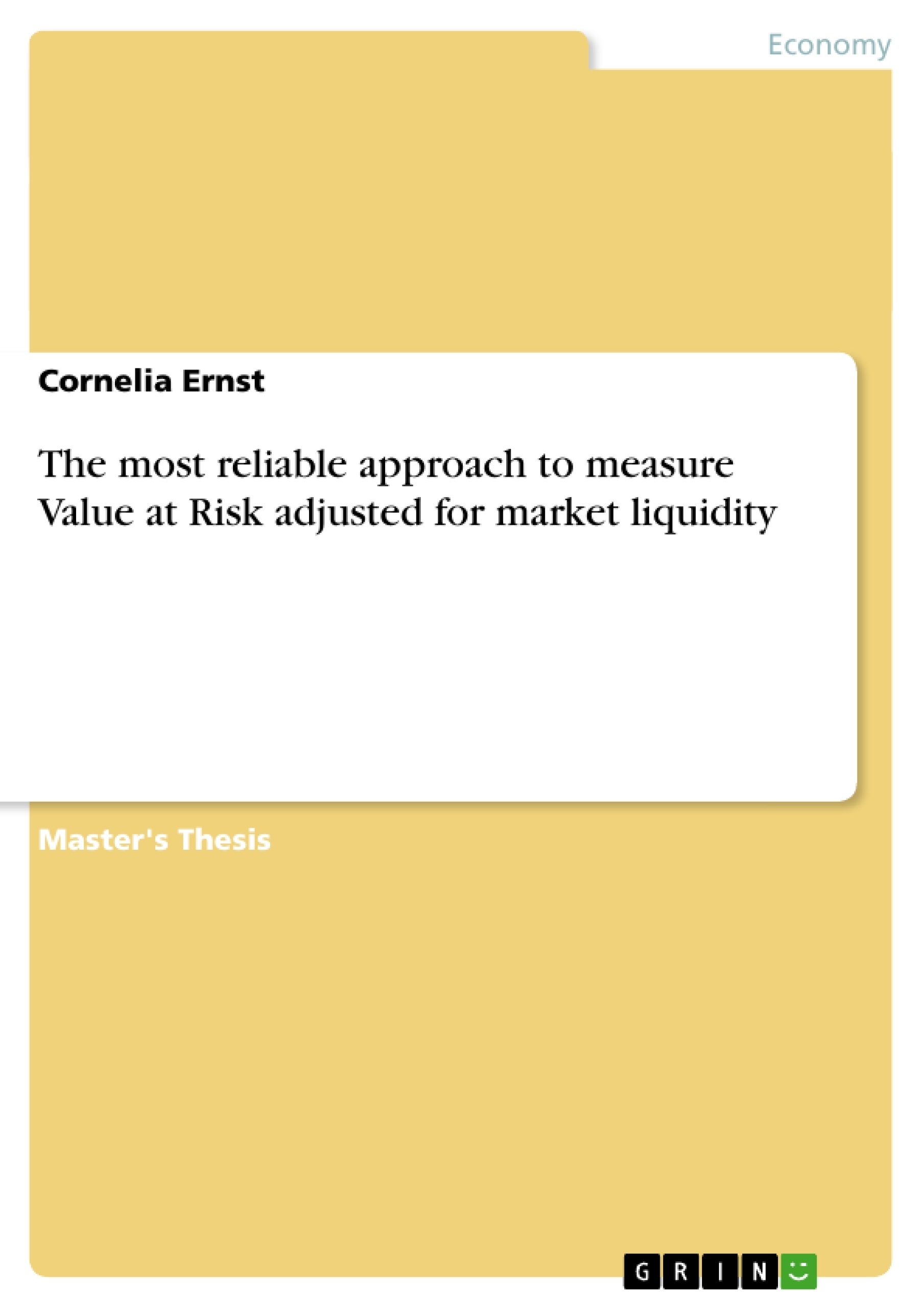Excerpt
Page 1
![]()
1 Introduction
The last months of the nancial market crisis and in particular the bankruptcy of the renowned investment bank Lehman Brothers, have taught us all that a nancial institution, failing to identify and address its risks appropriately, may rapidly face problems it is not able to handle on its own. Avoiding such problems requires a rigorous risk management not only in bad times but also in times where business is going and growing well.
Today, the most popular tool to measure, control and manage nancial risk within corporations and nancial institutions is the Value at Risk (VaR) concept.VaR measures the worst expected loss over a given horizon for a certain condence level. 1,2 However, since the computation of the traditional Value at Risk relies solely on market prices, one often criticized downside is its disregard of market liquidity risk, which is dened as the potential loss resulting from the time-varying cost of trading. 3 Due to the neglect of liquidity risk, the calculated VaR measures are suspected to be generally underestimated. 4 The underestimation of total risk can have undesirable consequences as the famous hedge fund Long Term Capital Management (LTCM) had to face in late 1998. LTCM experienced a spectacular downturn that was in large part aggravated by the neglect of liquidity risk. 5
Since the failure of LTCM, market liquidity risk has received a great deal of attention as it is felt to be insuciently covered by current risk management practices. 6 During the last few years several academic papers have been published on how to integrate liquidity risk in a conventional VaR framework. The solutions proposed can be classied into two groups: The rst one focuses on indirect liquidity cost measures by determining price quantity functions in order to account for liquidity risk. Among this stream, the approaches of Cosandey (2001), Jarrow and Protter (2005a), Berkowitz (2000b), Jarrow and Subramanian (1997) and Almgren and Chriss (2000) are widely known. In contrast, the second group makes use of direct liquidity cost measures such as the bid-ask spread or the order size dependent weighted spread. For instance Bangia et al. (1999b), François-
Cp.Dowd (1998), pp. 4-5. 1
The Basel Committee on Banking Supervision further stresses the importance of this risk measure by 2
stating in its 1996 Amendment to the Basel Accord that qualied nancial institutions are allowed
to have their capital requirements determined according to a standardized VaR approach. Cp. Basel
Committee on Banking Supervision (1996).
Cp. Jorion (2007), p. 333. 3
For instance cp. Bangia et al. (1999b), p. 3. 4
The coherence responsible for the failure of LTCM is very complex. For more information on this issue 5
and the role liquidity risk played in this part, for instance Jorion (2001), pp. 352-355 are recommendable.
Cp. President's working group on Financial Markets (1999). 6
Page 4
![]()
2 Market liquidity and liquidity risk
In literature there does not exist one single acknowledged denition of liquidity and liquidity risk. Instead, many dierent denitions coexist and consequently these are used very dierently in theory and practice. The objective of this chapter is to develop a consistent and meaningful denition of liquidity and liquidity risk serving as a foundation of this thesis.
Liquidity risk in general takes two forms: Market liquidity risk and funding liquidity risk. Market liquidity risk, often also called asset liquidity risk, is generally dened as the risk of not being able to immediately liquidate or hedge a position at current market 9 This kind of liquidity risk is a function of prevailing market conditions. Therefore,
prices.
it varies over time as well as among dierent assets. For instance, major currencies like the US-dollar can be liquidated easily without bearing signicant liquidity risk, whereas 10
trading exotic derivatives can signicantly aect prices.
In contrast to asset liquidity risk, funding liquidity risk which is also called cashow risk, refers to the inability to meet payment obligations. This may entail a forced liquidation of some portfolio positions at unfavorable conditions. Funding liquidity risk and asset liquidity risk are linked, if the portfolio that is to be liquidated, contains illiquid 11
- Quote paper
- Cornelia Ernst (Author), 2009, The most reliable approach to measure Value at Risk adjusted for market liquidity, Munich, GRIN Verlag, https://www.grin.com/document/154859
Publish now - it's free






















Comments